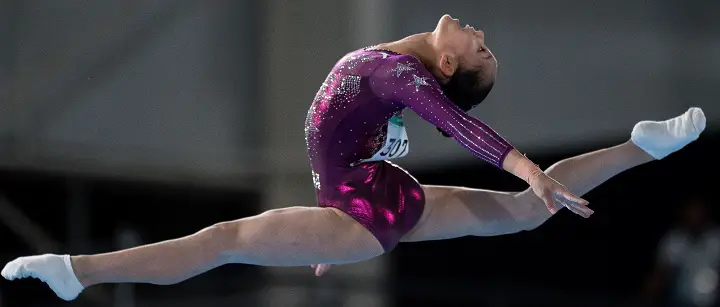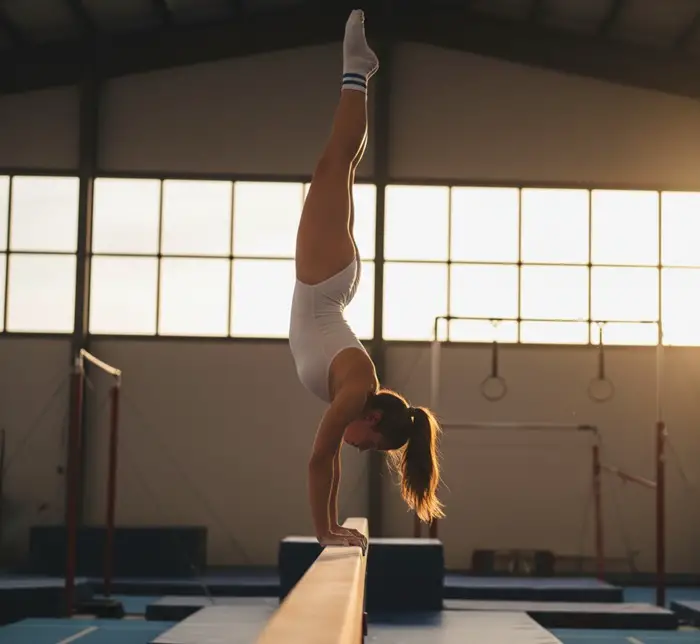
It’s likely that if you’ve ever seen a professional gymnastics competition on TV, you’ve noticed that several Olympians have begun wearing socks throughout their performance.
Around the time of the Rio de Janeiro Olympics, there was a vast number of athletes who were choosing socked feet, while many others preferred not to wear any socks or shoes during their game.
If you are a new gymnast and you’re trying to decide what you should be wearing on your feet during practice and competition, it is important to weigh the option between getting performance gear and keeping your feet well-protected.
The fact is, if you’re still relatively new at gymnastics, it could be wise for you to focus on protecting your toes and working to strengthen your feet with a thicker covering.
And this is where choosing the right footwear will play a significant role in the gymnastics game!
Do Gymnasts Wear Shoes?
Several gymnasts at the Olympics in Rio de Janeiro were seen wearing socks and shoes, and it was thought they could be receiving a slight performance advantage.
The judges had ongoing discussions about the use of shoes and socks, but since then, shoes have been seen much more widely in athletic competitions.
The basics of wearing shoes during athletic competitions like gymnastics are that you can enjoy a better grip on the apparatus. In addition, you will be able to get better turns on the floor as well as access better padding that can prevent injuries.
For routines that involve many twists and turns as well as high-flying, having these options can add advantages for the athlete and ensure that they can practice their routine more thoroughly without injuring themselves.
Why Do Gymnasts Prefer to Wear Socks?
Gymnasts are choosing to wear socks today because they allow them to turn better while they are on the floor, to have extra padding, and to make sure that they can get access to a better grip on any apparatus.
When training on uneven surfaces outdoors or on rough terrain, shoes along with socks are often beneficial to provide added protection and support for your feet.
Furthermore, gymnasts who have specific foot conditions should wear supportive footwear like grip socks and gymnastics ankle straps, but only as advised by a medical professional to ensure proper care and safety.
Having access to ankle socks can improve the skills of any gymnast, and they aren’t considered any type of performance enhancer from the perspective of judges either.
Not every gymnast will wear shoes and socks, however.
Most gymnasts will work out and perform their entire routine while they are completely barefoot.
They choose to go barefoot so that they can feel the mats and can participate in the same way that they may have practiced.
This direct contact with the surface provides a crucial sensory input that helps with balance, grip, and body awareness, which are vital for intricate movements and landings.

Pros and Cons of Wearing Shoes and Socks in Gymnastics
There are many pros and cons associated with using shoes and shoes while practicing and training on gymnastic equipment, such as the pommel horse, parallel bars, rings, and high bar, which require proper skills and attention.
If you are trying to weigh which option would be best for your needs as an amateur-level athlete during gymnastics and other athletic competitions, some of them are as follows:
The Pros
1. Enhanced safety and cushioning
Wearing shoes or even no show socks can add a layer of protection against impact and friction.
Gymnastic shoes, designed with thin yet shock-absorbent soles (often made of suede or microfiber), can reduce stress on the metatarsals during dismounts and hard landings.
They also guard against abrasions from equipment like the pommel horse or bars. Think of them as insurance for your feet — light, flexible, and protective.
2. Health and hygiene benefits
Training barefoot might look “natural,” but it exposes your feet to bacteria and fungi lurking on mats and gym floors.
Shoes or socks form a hygienic barrier, lowering the risk of athlete’s foot, toenail fungus, or skin irritation.
Plus, repetitive routines exert tremendous strain on ligaments and soft tissue — protective footwear can absorb some of that shock, reducing fatigue and overuse injuries.
3. Better stability and performance
Modern gymnastic shoes are engineered for precision. Their grippy soles enhance traction during tumbling or vaulting, while snug uppers offer midfoot support that helps maintain alignment during spins or flips.
Many gymnasts report improved control and balance — a small edge that can make a big difference in competition scoring.
The Cons
1. Reduced sensory feedback
Barefoot gymnasts enjoy a direct tactile connection to the apparatus — they can “feel” the beam, mat, or bar more acutely, helping fine-tune balance and landings.
Shoes, no matter how thin, add a barrier that dulls this feedback. Transitioning from barefoot to shod routines can initially throw off your proprioception and timing.
2. Potential distraction factor
Let’s face it — a flashy pair of shoes can steal the spotlight from your flawless routine. Judges (and audiences) might notice your footwear more than your form.
Unless uniform rules require protective footwear, many athletes prefer to keep the focus on their execution rather than their fashion statement.

What Type of Shoes and Socks Do You Wear During Gymnastics?
The type of shoes or socks gymnasts wear depends a lot on the apparatus, skill level, and discipline (artistic, rhythmic, trampoline, acro, etc.). Here’s a quick, expert-style breakdown:
Gymnastics Shoes
Gymnastics shoes (a.k.a. gym slippers or half shoes) are thin, lightweight, and designed to give athletes a near-barefoot feel while offering essential protection and grip.
Typically made from soft leather, suede, or microfiber, these shoes provide flexibility and allow natural foot movement during routines.
Their thin rubber or suede soles enhance traction without restricting balance or control, making them ideal for floor, bar, or vault exercises.
Beyond comfort, they help prevent burns and abrasions during intense landings and rotations.
Popular choices include Nike for men’s artistic gymnastics, Venturelli and Sasaki for rhythmic performances, and IWA or Adidas AdiStar for artistic gymnasts seeking precision and support.
When to wear:
- For men’s artistic gymnastics, especially on floor, vault, or rings, for added grip and cushioning.
- For women, used occasionally in training or during cold conditions, but most prefer barefoot for a better feel.
Gymnastics Socks or Toe Socks
Some gymnasts prefer wearing special grip socks instead of going barefoot, but these aren’t your everyday cotton pairs.
Made from breathable synthetic blends with silicone or rubberized grips on the sole, they’re designed to enhance traction on smooth mats while keeping feet warm and hygienic.
These socks help reduce the risk of slipping during training and can be particularly useful for trampoline or conditioning sessions.
Some athletes opt for toe socks to maintain better toe control, while others choose compression styles to improve circulation and reduce muscle fatigue during long practice hours.
When to wear:
- During warm-ups, light conditioning, or trampoline routines (where slippage risk is high).
- Rarely used in competition because socks can reduce tactile feedback and grip.

What Gymnasts Wear Other Than Shoes and Socks? Essential Protective Gear and Accessories
Beyond shoes and socks (which are often optional), gymnasts rely on a carefully chosen wardrobe designed for flexibility, safety, and precision.
Every piece of clothing plays a role in performance efficiency and body mechanics.
Typical gymnastics attire includes leotards or singlets, shorts, compression pants or leggings, fitted T-shirts, and supportive undergarments that stay discreet and secure during motion.
Wearing the right apparel isn’t just about looking competition-ready — it’s a blend of aerodynamics, freedom of movement, and safety.
The snug yet stretchable fabrics, usually a mix of spandex, Lycra, or nylon, allow full extension without snagging on apparatus or restricting form.
Proper gear, especially during the training period, also minimizes friction burns and reduces injury risk during high-impact landings or rotations.
And yes, there’s another advantage — streamlined outfits let coaches and judges clearly observe body alignment, posture, and technique, which can make or break a score.
Final Thoughts
whether you go barefoot, wear socks, or slip into gymnastic shoes depends entirely on your discipline, comfort, and training style.
Modern gymnasts face tremendous impact and rotational forces, so a little extra support can go a long way in protecting the feet, ankles, and tendons from strain.
Socks or shoes with proper grip can help absorb shock, improve traction, and reduce the risk of slipping on sweaty mats — all small factors that can make a big difference when every point counts.
Traditionalists may argue for the barefoot approach, but performance isn’t about tradition — it’s about precision, safety, and confidence. As long as your gear enhances movement and doesn’t interfere with form, it’s the right choice.
After all, gymnastics is about mastering control — and the right footwear (or lack thereof) should help you land safely, move freely, and perform like a champion.




